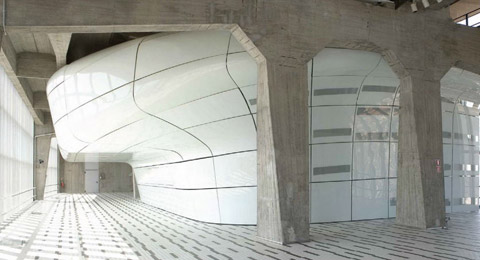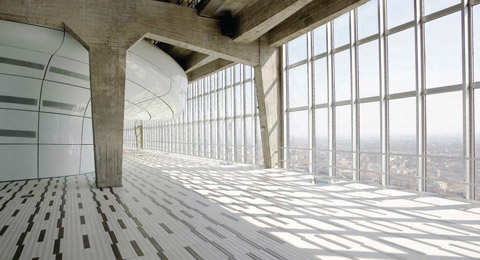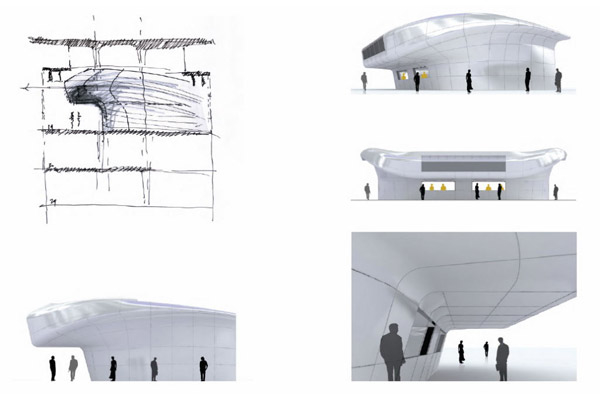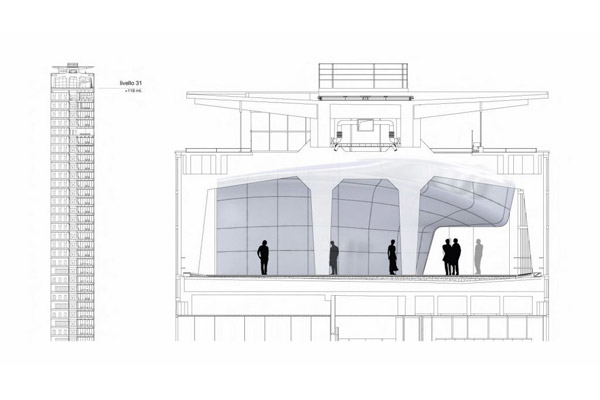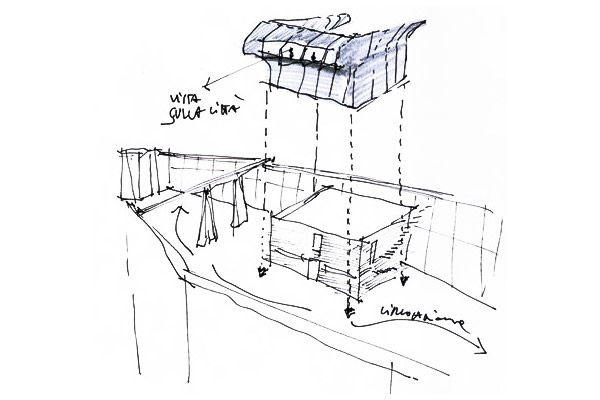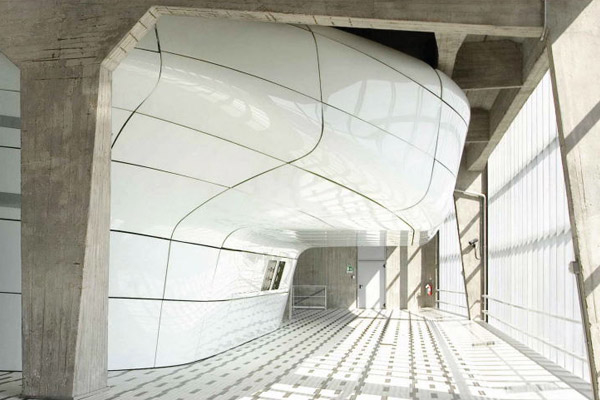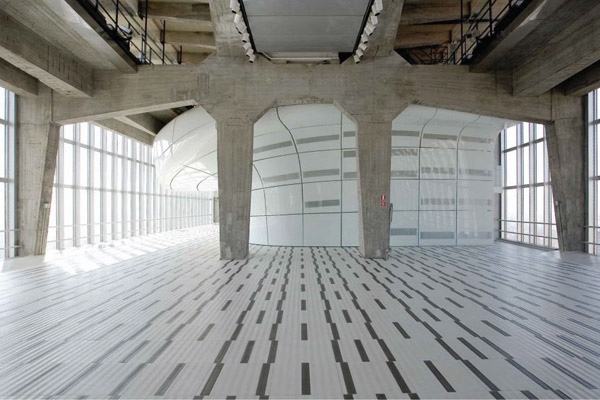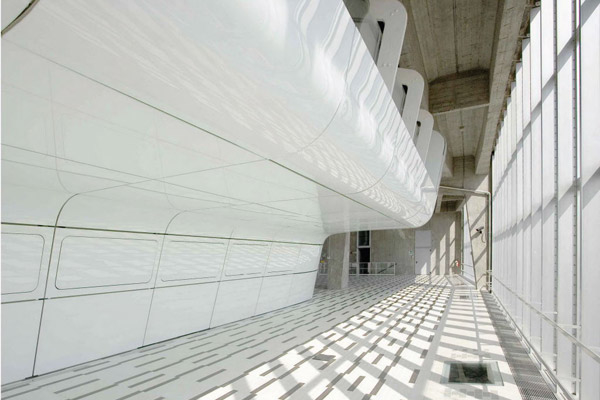Projekat: Belvedere
Lokacija: Pirelli soliter, Milano ,Italija
Dizajn: arh. Mauro Piantelli – De8 architetti, arh. Enrico Garbin – 2 architetti
Fotograf: Daniele Delonti
Projekat Belvedere u okviru Pirelli solitera u Milanu je deo takozvanog programa “AMATE L’ARCHITETTURA” koji za cilj ima prezervaciju i obnovu istorijskih i monumentalnih nepokretnosti u regionu Lombardija.
Nakon obnove objekta posle tragične avionske nesreće koja se desila u aprilu 2002. godine, realizovan je prostor “piazza alta”, na 31. spratu objekta, koji je originalno osmislio Giò Ponti u vidu javne platforme za posmatranje, trga na nebu. To je bio njegov način da nadoknadi prostor na tlu koji je zauzeo neboder.
Objekat se susreće sa nebom na ovom nivou i njegov kristalni monolitni izgled se tu rastvara.
Moderni spomenik
Pirelli soliter, pored toga što predstavlja repernu tačku Milana i ikonu italijanskih nebodera, podseća na ekonomski procvat 50tih godina u Italiji i na vrhunac italijanske arhitekture nakon Drugog svetskog rata.
To je moderan spomenik koji su projektovali Giò Ponti i Pier Luigi Nervi, i rezultat je perfektnog balansa između funkcije i forme. On definiše urbano okruženje Trga centralne stanice.
U ovom traganju za ispravnošću i funkcionalnošću detalji postaju od velikog značaja. Umetnički izraz objekta sagledava se u keramičkim oblogama, teksturama podova, betonskim izlivenim elementima itd.
Privilegija znanja
Svaki proces projektovanja počinje fazom izučavanja: teme, klijenta, lokacije. U ovom slučaju, takođe, spomenika i arhitekte.
Bila je privilegija izučiti objekat, posetiti ga, obići njegove prostore, osetiti ga; diskutovati genezu originalnog projekta sa gospodinom Egidio Dell’Orto, članom tima arhitekte Giò Ponti, izučavati ga kako bi razumeli logiku konstrukcije i plana, kako bi shvatili eleganciju detalja.
Ove informacije su baza novog projekta i ovaj input definisao je svaku projektantsku odluku: kao prvo karakter prostora u vidu otvorenog vidikovca.
Privilegija znanja doprinosi jedan javni prostor – 31. sprat Pirelli solitera poklonjen je gradu i formira jedan osetljiv urbani prostor.
Naos
31. sprat je otvoren prostor duple visine opkoljen prirodnim svetlom koje prodire kroz istočno-zapadnu staklenu fasadu. Moćna betonska struktura u kombinaciji sa svetlom daje prostoru sakralnu auru. To je neka vrsta svetovnog naosa. Tehnički volumen mašina za liftove prekida tako fluidan prostor. Prvobitno nukleus je obložen keramičkim pločicama kao i svi drugi tehnički volumeni dajući spratu karakter preostalog prostora.
Belvedere – Proces projektovanja
Proces projektovanja prvenstveno se odnosi na proces de-materijalizacije. Građevinski materijal je svetlo.
Projekat nastaje iz najpre emotivnih osećanja a ne funkcionalnih zahteva.
Da bi se rekonfigurisalo jedinstvo naosa nukleusi liftova obavijeni su staklenom opnom u celoj visini staklene fasade. interferentni neproziran volumen je svetao.
Belvedere – Značenja dizajna
Cilj stvaranja fluidnog prostora i njegove dematerijalizacije doveo je do formiranja ljuske od belog stakla (dubinski bele boje radi percepcije staklene materijalizacije) koja okružuje tehnički volumen.
Tragajući za efektom lakoće, ljuska je potpuno odvojena od postojeće strukture. Takav materijal i oblikovna nezavisnost naglašavaju jačinu mase betonske strukture i njenih statično generisanih profila koji su u kontrastu sa krhkom staklenom opnom.
Sve ostalo rezultat je odnosa prema radu arhitekte Giò Ponti: keramički podovi, teksture, jasnoća dizajnerskih odluka.
Belvedere – Funkcionalni program
Belvedere je javni trg namenjen za različite upotrebe. Služi kao prostor za izložbe, konferencije, koncerte i drugo. Takođe ima institucionalnu ulogu kao mesto za zvanične sastanke i druge događaje lokalne samouprave.
Belvedere pruža privilegovan direktan i virtuelan pogled na grad i njegove promene (postavljeni su monitori povezani preko interneta koji prikazuju uživo slike sa aktivnih lokacija).
Project: The Belvedere
Location: Pirelli Skyscraper, Milan, Italy
Design: arch. Mauro Piantelli – De8 architetti, arch. Enrico Garbin – 2 architetti
Photographer: Daniele Delonti
The project of the Belvedere on the Pirelli Skyscraper in Milan is part of the so called program “AMATE L’ARCHITETTURA” to preserve and renovate the historical and monumental real estate assets of the Region Lombardy.
Following the philological restoration of the building after the tragic airplane accident in April 2002 the realization of a “piazza alta” at the 31st floor of the Palazzo configure the original vision of Giò Ponti of a public viewing platform, a piazza in the sky. It was his way of giving back to the city the ground space stolen by the skyscraper’s footprint.
The building meets the sky at the Belvedere level and its crystal monolithic appearance dissolves.
The Modern Monument
The Pirelli Skyscraper, beyond being a landmark of Milan and the icon of the Italian skyscrapers, resembles the economic boom of the 50s in Italy and the climax of the Italian Architecture after the Second World War.
It is a modern monument, design by Giò Ponti and Pier Luigi Nervi, and the result of the perfect balance between form and function. It defines the urban environment of the Central Station Square.
In this research for exactness and functionality, detailing assume a relevant importance. The artistic vocation of the building is visible in the ceramic tiles cladding, on the flooring textures, on the concrete moulding, etc.
The privilege of knowledge
Each design process starts from a knowledge phase: the topic, the client, the site. In this case also the monument and the architect.
It has been a privilege to enter the building, to visit it, to walk through it, to feel it; to discuss the genesis of the original project with Egidio Dell’Orto, member of the Giò Ponti’s design team, to study it, to understand the structure and plan logic, to contemplate the detailing elegance.
These are the basis of the new project and from these inputs came each design decision: as first the vocation of the space as an open Belvedere.
The privilege of knowledge becomes public, the 31st floor of the Pirelli Skyscraper is donated to the city and becomes a sensible urban site.
The Nave
The 31st floor is a double height open space wrapped by natural light coming from the east west glass facade.
The powerful concrete structure together with light gives the space a sacral aura. It is a sort of laic nave.
The technical volume of the elevators’ machines interferes in such a fluent site. In the original status the nucleus was clad with ceramic tiles like all others technical volumes giving to the floor the character of a left over space.
Belvedere – Design process
The design process is primarily a de-materialization process. The building material is light.
The project generates from emotional feelings more than functional requirements.
To reconfigure the unity of the nave the elevators’ nucleus is wrapped by a glass skin reversing inside-out the total height glass façade. The interferent opaque volume is made lucent.
Belvedere – Design meanings
The goal of creating a fluid space together with its dematerialization lead to realize a POD in white glass (in depth white to perceive the glass materiality) wrapping the technical volume.
Searching for lightness the POD is totally detached from the existing structure. Such material and formal independence exalts the muscular mass of the concrete structure and its static generated profiles in contrast with the fragile glass skin.
Everything else refers to Giò Ponti’s visions: on the ceramic flooring, on the textures, on the clarity of the design decisions.
Belvedere – Functional program
The Belvedere is a public square to be exploited in a number of different ways. It serves as a space to stage itinerant exhibitions, conferences, concerts and so on. It also plays an institutional role as a venue for local government events and official meetings.
The Belvedere offers a privileged direct and virtual view over the city and its changing process (walkable monitors connected via web display live images of in progress sites).


